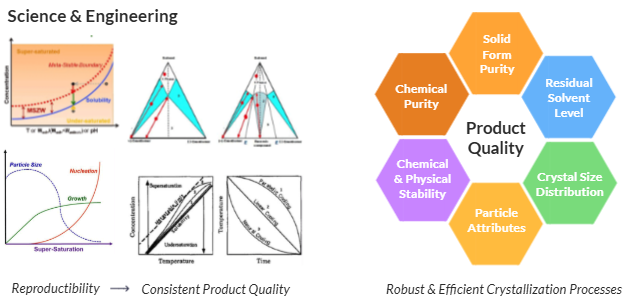Crystallization Process Development
Crystallization processes, especially for final API isolation, serve as quality-control steps for API products. These processes should be designed and controlled to meet predefined product quality attributes to ensure the safety and efficacy of the final drug product as required by government regulators. 1Cerulean Associates, Why Quality by Design? An Executive’s Guide to the FDA’s Quality by Design, March 2008, https://ceruleanllc.com/wp-content/articles/eReport_QbD_Executive_Guide_CERULEAN.pdf. But even today, many chemists and managers in the pharma industry regard crystallization processes as more of an art than a science. CfPC takes the opposite view. It believes that rigorous application of relevant scientific and engineering principles to each aspect of the crystallization process not only builds in quality but also increases the efficiency and stability of the process itself.

Good process understanding is key to these efforts. Achieving this understanding enables the right process design and control to meet predefined CQAs of the product. For example, CfPC has frequently been called on to address the problem of “oiling out” during the crystallization process-a major headache for API process development. In one case, an API needed to be isolated into three different anhydrous polymorphs, but all of them encountered an oiling-out issue during process development elsewhere. Finding solutions started with the collection of phase boundary data for respective solvent systems within practical ranges of critical processing parameters. Analysis of these data allowed CfPC to quickly define the process space for each polymorph that prevented oiling out while simultaneously addressing additional challenges, including control of particle size distribution (PSD) and yield maximization. The fundamental understanding gained about the compound/polymorph/solvent system ultimately sped up the process development, enabled robust process control, and increased the yield of delivery batches for the drug’s formulation development. 2Food & Drug Administration, Guidance for Industry Quality Systems Approach to Pharmaceutical CGMP Regulations, September 2006, https://www.fda.gov/downloads/Drugs/Guidances/UCM070337.pdf. Such challenges get addressed effectively via the approach taken by CfPC.
A common demand for final API crystallization process is to meet specifications of particle attributes, such as PSD, crystal morphology or shape, and bulk density. For example, during early drug development, API crystals with different PSDs are often prepared for preliminary formulation evaluations. Once the desired PSD range is defined or selected, the API manufacturing process must be able to consistently produce the same PSD in every batch of product. Both early API deliveries with different PSDs and robust manufacturing of drug substance meeting target PSD face technical challenges and resource constraints in development. Preventing the generation of undesired forms during API processing has long been a top priority for drug developers and manufacturers. A good understanding of the thermodynamics and kinetics of a specific system is essential to designing the right process in the first place or to solving problems that arise during process development, scale-up, and technology transfer. For crystallization processes developed elsewhere, CfPC scientists have quickly addressed multiple cases of late appearance of a new polymorph via accurate measurement of solubility profiles and metastable-zone width data. The right fundamental data enables the right solution to a challenging problem.
To better understand and control the crystallization processes, real-time in-process information is monitored and analyzed by process analytical technologies (PATs). Focused beam reflectance measurement, BlazeMetrics, process Raman, and ReactIR are routinely applied by CfPC scientists during process development. Use of these tools facilitates the collection of valuable information from limited experiments that are otherwise difficult to achieve. For instance, using the imaging capability of BlazeMetrics, the latest PAT tool, CfPC experts quickly discovered the hidden complication in isolation of a target crystal form. A metastable form generated in an earlier part of the process was detected by both images and Raman signal via BlazeMetrics before conversion into the more stable target form later. Such information facilitates the process optimization with unmatched effectiveness. We utilize a science-based approach that builds quality into the process including the following steps:
- Information Gathering & Evaluation
- Solvent Screening & Selection
- Thermodynamic and Kinetic Data Collection
- Process Design Testing and Optimization
- CPPs Evaluation and PAR Study
- Control Strategy Implementation
- Process Demonstration
- Technical Transfer

